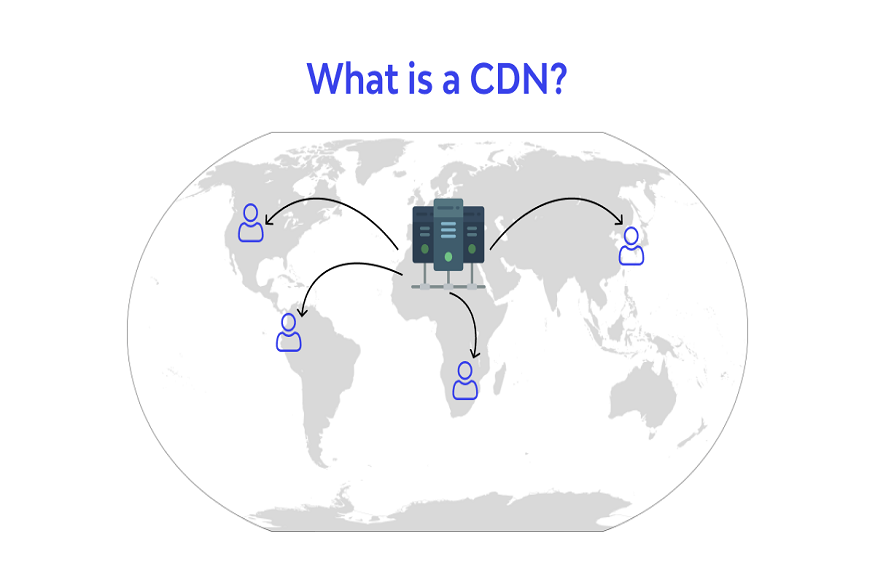Key Takeaways
- CDNs are enhancing ad delivery by improving performance, reliability, and reducing bandwidth costs.
- They improve user experience by decreasing page load times and bounce rates, thus increasing ad delivery efficiency.
- CDNs significantly lessen the demand on origin servers, leading to lower web hosting costs.
- For online businesses, CDNs are crucial in improving page speed, an essential aspect of ad delivery.
Delivering ads that effectively engage and convert is a challenge for every online business. More companies are now leveraging Content Delivery Networks (CDNs) to address this challenge. A CDN is a network of geographically distributed servers that provide cached internet content from a location closest to the user to enhance delivery speed. CDNs in ad delivery are not just about speed; they also improve reliability, performance, and cost-effectiveness. Let’s explore how CDNs are transforming the landscape of ad delivery.
Revolutionizing Ad Delivery with CDNs
As the demand for real-time, personalized, and high-quality content increases, ad delivery is undergoing a significant transformation. CDNs are at the forefront of this change, offering performance and reliability that surpass traditional ad delivery methods. They ensure that ads reach the target audience promptly and smoothly, regardless of geographical location. This timely and efficient delivery enhances user experience and increases the likelihood of ad engagement and conversion.
One of the notable advantages of using CDNs for ad delivery is cost savings. By reducing bandwidth costs, CDNs make high-volume ad delivery economically feasible. Distributing ad content via a CDN is like taking a direct flight to your destination—faster, more efficient, and cost-effective.
Online user experience is a critical factor that can determine the success of an ad campaign. CDNs improve user experience by reducing page load times and bounce rates. Studies show that users are more likely to engage with an ad if the page loads quickly. CDNs ensure that ad content is delivered with minimal latency, keeping the audience engaged and reducing the likelihood of them leaving the page.
Another significant advantage of CDNs is that they reduce the demand on origin servers, resulting in lower web hosting costs. Imagine managing a large crowd at your door; instead of letting them all in at once, causing chaos, you have a system that allows them in gradually and in an organized manner. This is what a CDN does—it efficiently manages traffic, reducing the strain on the origin server and preventing potential server crashes and associated costs.
For online businesses, page speed is crucial, especially for ad delivery. Slow-loading pages can result in lost customers and revenue. CDNs address this challenge by caching ad content on their network of servers, ensuring that ads load quickly regardless of user location. This not only enhances user experience but also boosts ad engagement and conversion rates.
CDNs in Streaming and Live Events
A Content Delivery Network (CDN) aims to enhance web performance by minimizing the time required to deliver content and rich media to users. This is especially critical for streaming and live events, which demand the real-time transmission of high-quality content to keep users engaged. In this scenario, CDNs are essential in ensuring smooth content delivery to users worldwide.
CDNs greatly improve the user experience in streaming and live events by facilitating the transfer of content to multiple servers globally. This widespread distribution means users can access content from the nearest server location, thereby reducing latency and buffering issues. Consequently, viewers experience smoother streaming with minimal interruptions.
Website security and reliability are vital, particularly for streaming and live events that draw large audiences. CDNs bolster a website’s security and dependability, making it less prone to cyber-attacks and downtime. By distributing content across several servers, a CDN enhances a website’s resilience against security threats and operational failures, which is crucial for streaming and live events that must maintain consistent uptime and security.
CDNs operate mainly by caching static content, which is vital for the delivery of large video files in streaming and live events. By storing these files on their servers, CDNs can swiftly deliver content to users, enhancing the streaming experience while easing the load on the origin server, thus improving its overall performance and reliability.
The surge in non-scripted programming and live events is shaping the future of the entertainment industry. CDNs are pivotal in this evolution due to their ability to deliver content swiftly and reliably. They manage a significant portion of web traffic, including traffic from major websites like Facebook, Netflix, and Amazon. As the demand for non-scripted programming and live events continues to rise, the importance of CDNs in delivering this content will only grow.
CDNs Impact on Small Business Marketing
As the streaming ad marketplace continues to evolve, small businesses are ramping up their marketing expenditures. This shift stems from the growing awareness of the crucial role effective ad delivery plays in attracting and retaining customers. As the marketing landscape becomes increasingly digital, the significance of CDNs in ensuring reliable ad delivery intensifies.
CDNs are essential for small business ad delivery, enabling the swift and efficient distribution of ads to potential customers across the globe. In today’s rapid digital environment, where consumer attention is fleeting, this speed and efficiency are vital. Moreover, CDNs can manage large volumes of traffic, ensuring ads reach their intended audience even during high-traffic periods.
Ineffective ad presentation or performance can severely impact small businesses, leading to the loss of potential customers and reduced sales. In extreme cases, it can tarnish the business’s reputation. Therefore, dependable CDN services are critical for the seamless and efficient delivery of ads.
For small businesses in the streaming ad marketplace, CDNs can be transformative. They enable smaller enterprises to compete with larger companies that have greater resources. By utilizing CDNs, small businesses can ensure their ads are delivered swiftly and efficiently, offering a user experience comparable to that of larger corporations.
As trends in small business marketing continue to develop, CDNs must evolve to meet these changing demands. For instance, with the growing adoption of video marketing by small businesses, CDNs must be capable of delivering high-quality video content. With their capacity for quick and reliable content delivery, CDNs are well-equipped to meet the future demands of small business marketing.
Enhancing User Experience with CDNs
The effectiveness of a CDN is evident in its ability to enhance user experience through reduced page load times and improved content delivery efficiency. By caching content closer to the user, CDNs significantly reduce lag and latency associated with data transfer. This faster content delivery translates into quicker page load times, providing a smoother and more enjoyable user experience. It’s no surprise that businesses are turning to CDNs to improve latency.
Another crucial role CDNs play in enhancing user experience is reducing bounce rates, which measure the percentage of visitors who navigate away from a website after viewing only one page. A high bounce rate often indicates a poor user experience, typically associated with slow page load times. By speeding up content delivery, CDNs help keep users engaged and reduce bounce rates. This benefits both users, who get the content they want faster, and businesses, which retain more site visitors.
For online businesses, page speed is a key determinant of user experience. Slow page loads can frustrate users, leading to lower engagement and potentially lost sales. CDNs, with their distributed networks, are uniquely positioned to improve page speed by delivering content from servers closer to the users. This proximity reduces data travel time, resulting in faster page loads and a better user experience.
Looking to the future, user experience trends indicate an increasing demand for faster, more efficient content delivery. Video streaming, live events, and interactive web applications are becoming more prevalent, all requiring robust and reliable content delivery networks. CDNs must adapt and evolve to meet these demands, focusing on improving speed, reliability, and security to provide the best possible user experience.
CDNs are pivotal in improving the user experience of streaming and live events. With their ability to handle large amounts of data, CDNs can deliver high-quality video streams and live event feeds without buffering or lagging. This seamless viewing experience is crucial in keeping audiences engaged and ensuring the success of streaming and live events.
Future Challenges and Opportunities for CDNs
As technology evolves, CDNs face new challenges. One such challenge is the increased demand for real-time applications, augmented reality (AR), and virtual reality (VR) content. These technologies require instantaneous data delivery for an immersive and seamless user experience. CDNs must develop innovative solutions to manage this increased data load and speed requirements.
The advent of 5G presents a significant opportunity for CDNs, with its potential to revolutionize content delivery dynamics. 5G’s increased bandwidth and lower latency can enhance CDNs’ effectiveness, enabling faster and more efficient content delivery. This advancement could lead to a new era of streaming quality and speed, making real-time content delivery more accessible.
The rise of Machine Learning (ML) and Artificial Intelligence (AI) also heralds a new frontier for CDNs. These technologies can enhance predictive content caching and delivery, making the content delivery process more efficient. By predicting user behavior and preloading content accordingly, CDNs can further improve user experience and reduce bandwidth usage.
Collaboration is another avenue for CDNs to explore for future growth. By partnering with Internet Service Providers (ISPs) and other stakeholders, CDNs can optimize content delivery paths, reducing latency and improving end-user experience. This synergy could lead to a more robust and resilient internet infrastructure capable of handling the ever-increasing global data traffic.
Future trends in CDN technologies suggest a continuous evolution to meet changing needs. Whether adapting to new content formats, improving data security, or leveraging emerging technologies, CDNs must constantly innovate. As the digital landscape evolves, CDNs must adapt to ensure fast, secure, and reliable content delivery.
In the face of these challenges and opportunities, CDNs like CacheFly can help increase a website’s security and dependability, making it less susceptible to security attacks and downtime. As the content is served from numerous servers, a CDN enhances security and reliability. While the future brings new challenges, it also brings opportunities for CDNs to continue improving user experience and shaping the future of content delivery.






